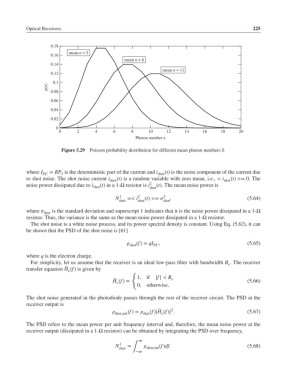Page 244 - Fiber Optic Communications Fund
P. 244
Optical Receivers 225
0.18
mean n = 5
0.16
mean n = 8
0.14
mean n = 11
0.12
0.1
p(n)
0.08
0.06
0.04
0.02
0
0 2 4 6 8 10 12 14 16 18 20
Photon number n
Figure 5.29 Poisson probability distribution for different mean photon numbers n.
where I PC = RP is the deterministic part of the current and i shot (t) is the noise component of the current due
I
to shot noise. The shot noise current i shot (t) is a random variable with zero mean, i.e., < i shot (t) >= 0. The
noise power dissipated due to i shot (t) in a 1-Ω resistor is i 2 shot (t). The mean noise power is
N 1 =< i 2 (t) >= 2 , (5.64)
shot shot shot
where shot is the standard deviation and superscript 1 indicates that it is the noise power dissipated in a 1-Ω
resistor. Thus, the variance is the same as the mean noise power dissipated in a 1-Ω resistor.
The shot noise is a white noise process, and its power spectral density is constant. Using Eq. (5.62), it can
be shown that the PSD of the shot noise is [61]
(f)= qI , (5.65)
shot PC
where q is the electron charge.
For simplicity, let us assume that the receiver is an ideal low-pass filter with bandwidth B . The receiver
e
̃
transfer equation H (f) is given by
e
{
1, if |f| < B e
̃
H (f)= (5.66)
e
0, otherwise.
The shot noise generated in the photodiode passes through the rest of the receiver circuit. The PSD at the
receiver output is
̃
2
shot,out (f)= shot (f)|H (f)| . (5.67)
e
The PSD refers to the mean power per unit frequency interval and, therefore, the mean noise power at the
receiver output (dissipated in a 1-Ω resistor) can be obtained by integrating the PSD over frequency,
∞
N 1 = (f)df. (5.68)
shot ∫ shot,out
−∞

